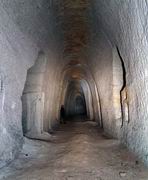
The remains of the former kaoline mine, which is the unique technical sight, are situated about 3 km north-west of the town České Budějovice in the neighbourhood of the small village Hosín.
The mining of kaoline started here in the second half of the 19th century. The mined kaoline was floated in long wooden mangers to obtain fire resistant form for ceramic manufacturing in the Hardtmuth company in České Budějovice. Sand after floating was stored in piles and later it was extracted for producing artificial marble and roof tiles.
The mining was stopped at the beginning of the 20th century. The name Orty is a Czech term for German expression meaning forefield, working place in the pit.
The pit has three parts - Hosín I, Hosín II and Hosín III. Its depth is between 5 m and 15 m under the surface. All corridors (about 3.5 km long) were tunnelled manually.
The most interesting place in the pit is a dome called Charon. Several metres high space (cave) originated after the collapse of the part of mine ceiling.
The remains of the pit are protected.
Plan of the underground (by David Kaifoš and Michal Kolčava)